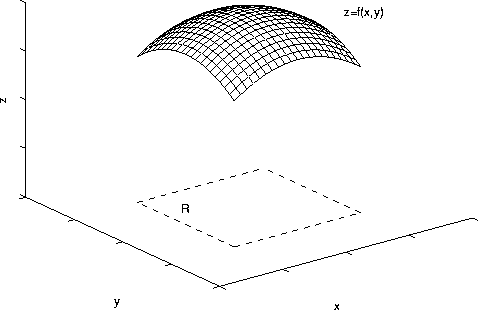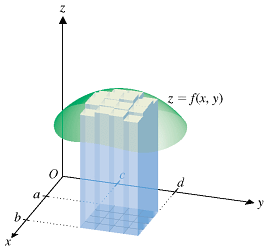Surface Area
Basic Idea
Let's say we want to find the surface area of the curve shown above. We split it up into many boxes, and sum up the areas of each square. Notice that the "squares" aren't actually squares, but as the number of "squares" approaches infinity, that part of the surface becomes essentially flat, and then it's just the area of a square.
Calculate Area
Without being too rigorous, pretty much we're adding up the area (magnitude of the cross products) for each point (x,y). We've seen this before! Double integration! $$\int\int|r_u \times r_v| dx dy$$
Case of z = f(x,y)
Example
First, we have to find the partials. $$r_u = < v, 1, 1>$$ $$r_v = < u, 1, -1>$$ $$r_u \times r_v = <-2, u + v, v - u>$$ $$|<-2, u + v, v - u>| = \sqrt{4 + 2u^2 + 2v^2}$$ Notice how we can convert this to polar. We let $u^2 + v^2 = r^2$, and it becomes really easy, because the region is within a circle of radius one. Remember we have to multiply by r first. $$\int_0^{2\pi}\int_0^1r\sqrt{4 + 2r^2}\, d{r} \, d\theta{}$$ Notice how nothing is in terms of theta, so you can turn the outer integral into a scalar $2pi$. Now, we have a one dimensional integral. $$2\pi\int_0^1r\sqrt{4 + 2r^2}\, \mathrm{d}r$$ All you have to do now is a u-substitution, and you get $\boxed{\frac{\pi}{3}(6\sqrt{6} - 8)}$
David Witten



